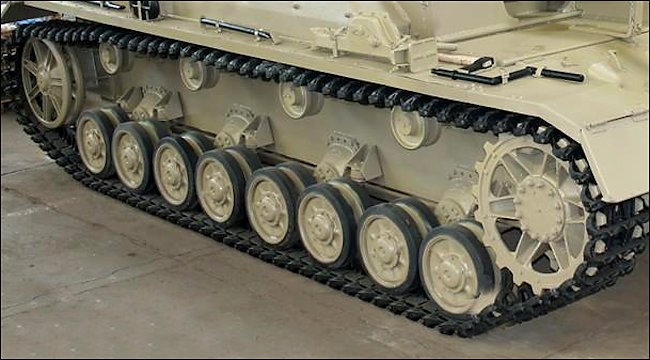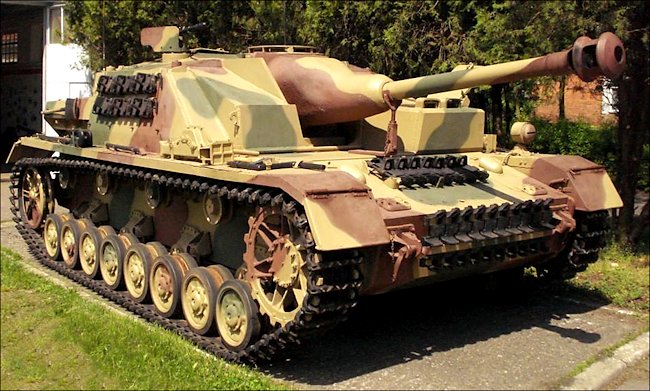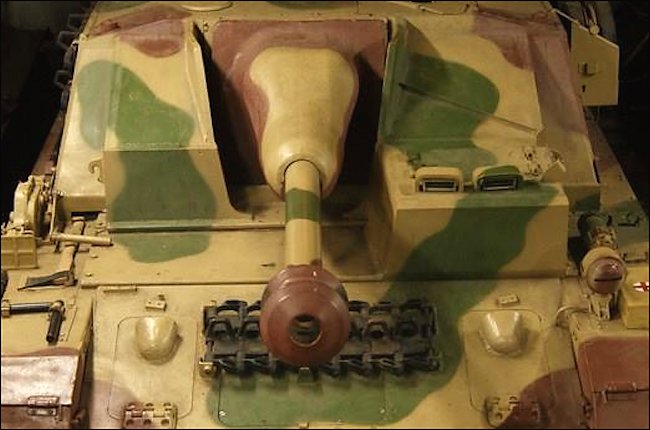The StuG IV Tank Destroyer
This German StuG IV Sturmgeschütz 75mm Tank Destroyer Sd.Kfz.142 can be found at the Armoured Weapons Museum, Land Forces Training Centre, Poznań, Poland.

German StuG IV Sturmgeschütz 75mm Tank Destroyer at the Armoured Weapons Museum, Land Forces Training Centre, Poznań, Poland.
It has been restored to a running condition. This vehicles sunk in the iced river Rgilewka (near Grzegorzew, Poland) in January 1945, when its crew tried to cross it. The upper part of the hull was recovered in 2006. The lower part of the StuG IV was recovered in July 2008. The restoration of the vehicle ended in Summer 2009. The very good preservation conditions on the bottom of the Rgilewka river allowed the vehicle to be restored to running condition. http://www.wirtualne.muzeumbronipancernej.pl
The easiest way to tell a StuG III from a Stug IV is to count them number of road wheels. A Stug III has six road wheels and a StuG IV has eight as it has a longer chassis and is based on the Panzer IV tank and not the shorter Panzer III. Normally the Panzer IV tank has 4 Returnroller on the upper section of the track but both 3 and 4 Returnroller-versions were produced side by side, starting in december 1944.

A Stug III has six road wheels and a StuG IV has eight as it has a longer chassis.
Why was the StuG IV built?
The Sturmgeschütz IV assault gun was more commonly known as the Stug IV. Unlike the StuG III it was mainly used as an anti-tank weapon rather than infantry support. It was a tank destroyer that hunted in packs of three or four vehicles. It's very low profile, made it ideal for hiding in woods, behind hedges and inside buildings was waiting to ambush Soviet or Allied armoured vehicles.
It was cheaper and faster to build a StuG IV tank destroyer than a tank. The Panzer III tank chassis was used to construct the StuG III assault gun. The Panzer IV tank chassis form the basis of the StuG IV conversion. The main armament was a 75mm StuK 40 L/48 gun. Each vehicle could carry 63 rounds of ammunition.
It was a four man crewed vehicle: commander, gunner, loader and driver. They were protected by 80 mm of armour at the front of the vehicle. There is also a top mounted 7.92mm machine gun. To get out of danger, it had a top speed of 25 mph (40km/h).

StuG IV 7.5cm Tank Destroyer at the Muzeum Broni Pancernej w Poznaniu - oddział Muzeum Wojska Polskiego, Poland
A report on how the StuG III had performed well during the battle of Kursk reached Hitler's desk. He had already ordered the development and production of the Jagdpanzer IV that used a Panzer IV tank chassis and a Panzer V Panther's 75mm L/70 gun. Allied bombing of the factory where the StuG III was produced and the lack of availability of the Panther's gun led to Hitler ordering the StuG IV into production by Krupp-Gruson company at Magdeburg, who had been producing Panzer IV tanks.
There were 1,108 new StuG IV assault guns made plus 31 conversions, between late 1943 and 1945. The vehicle weighed 23 tonnes and was powered by a V12-cylinder Maybach HL 120 TRM 300 PS (296 hp, 220.6 kW) diesel engine. It had an operational range of 210Km (130 miles).

StuG IV 7.5cm Tank Destroyer at the Muzeum Broni Pancernej w Poznaniu - oddział Muzeum Wojska Polskiego, Poland
You can easily identify whether you are looking at a StuG III or IV by counting the small track wheels. The StuG III has six each side, whilst the StuG IV has eight. Zimmerit anti-magnetic mine paste was applied to the outside of many of the vehicles. Additional armour skirt plating was added as a defence against Russian anti-tank guns and American bazookas.
Many crews strapped on spare track to the front of their vehicles for added protection. The track was often fitted with track extenders, to make the track wider, so it could better cope with the snow and boggy conditions found in some of the Russian landscape. You will often see spare track wheels attached to the rear of StuG IV assault guns. These were for the crew to use after they had run over a mine.
The Stug IV used the same improved design features that were added to the late model Stug III assault guns. A folding machine gun shield was added to the top of the vehicle. The commander's hatch was a cupola. These machines were used on the Russia front, in the defensive of Italy and fighting the Allied invasion of Normandy.
Where can I see more StuG IV Tank Destroyers?
- Muzeum Broni Pancernej (MBP) Poznań, Poland
- Museum im, Orła Białego, Skarżysko-Kamienna, Poland
- Sventes Muiža Hotel's Military Vehicle Museum, Latvia
WW2 tank books

